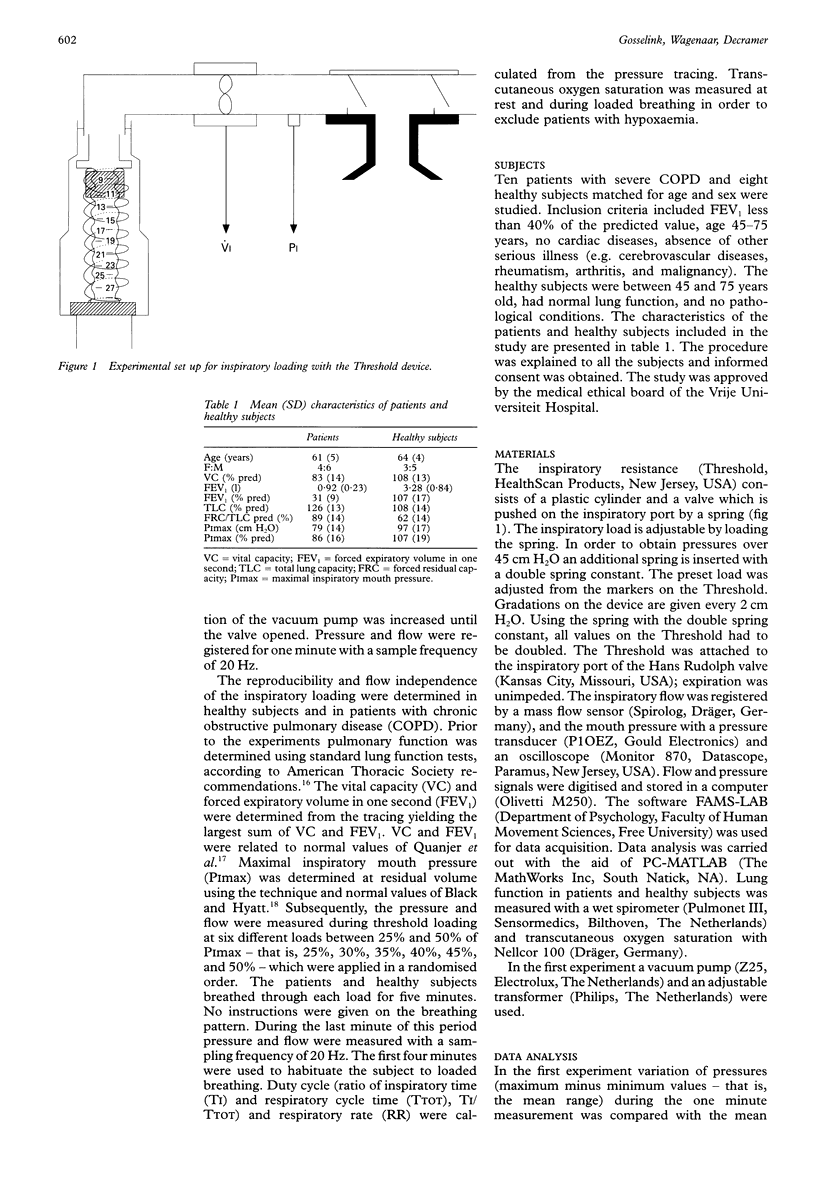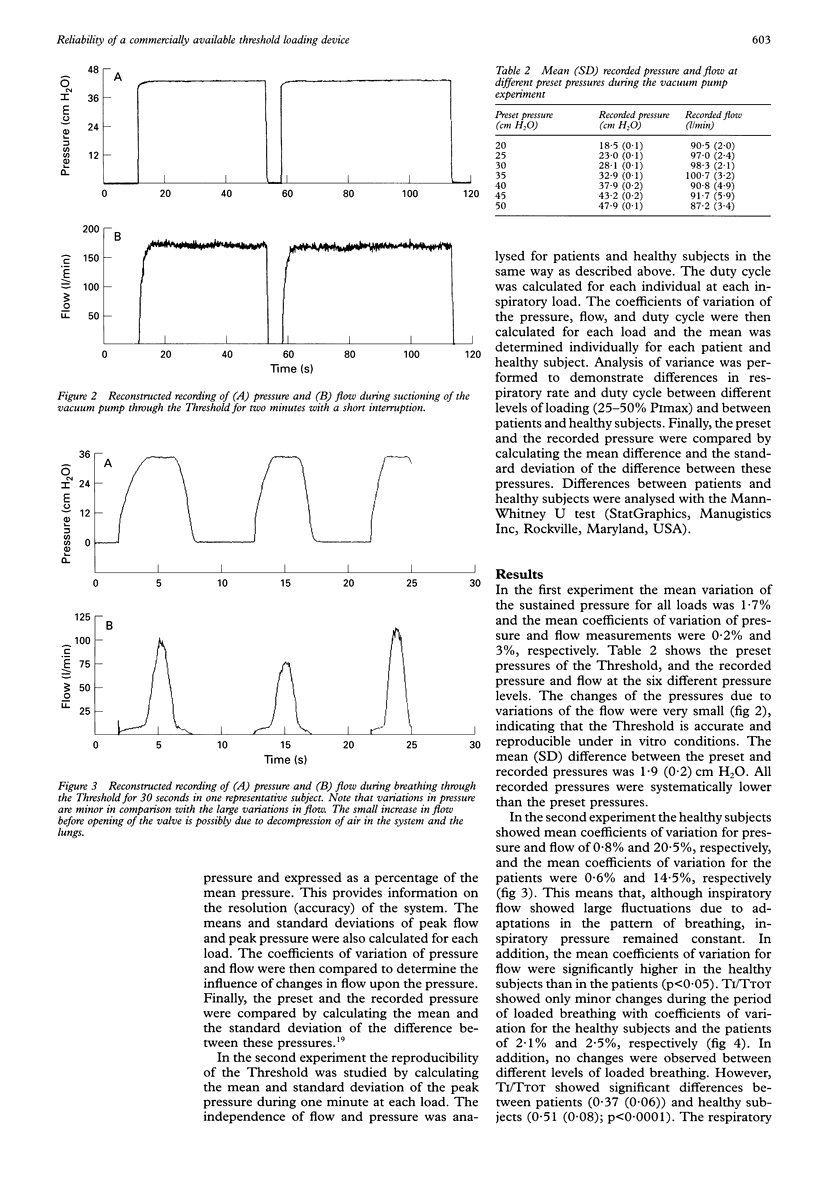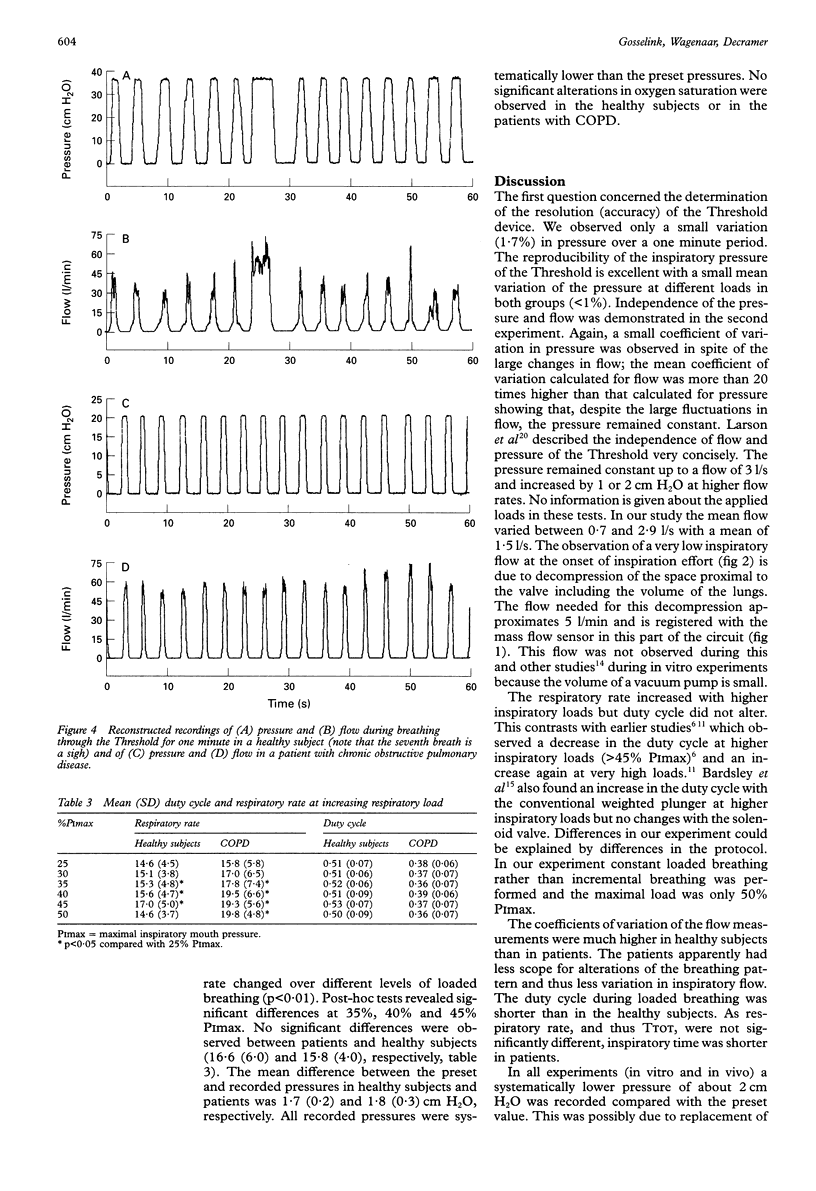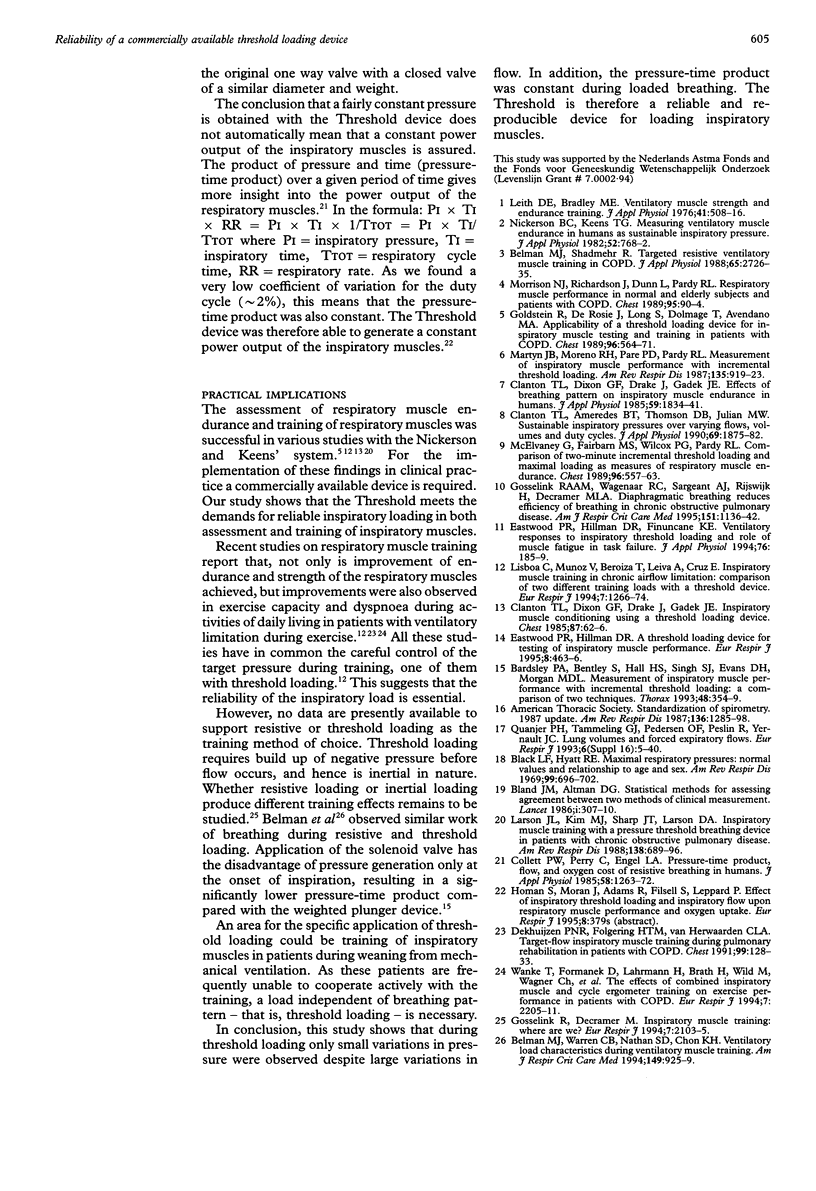Abstract
BACKGROUND: Threshold loading with the Nickerson and Keens' device is frequently applied in the training and assessment of inspiratory muscles. However, this equipment is not easily applied in clinical practice and training. A study was therefore designed to investigate the accuracy and reliability of the Threshold, a commercially available threshold loading device. METHODS: The resolution (accuracy) of the system was determined by measuring variation of pressure and flow during one minute in an experimental setup. The reproducibility and flow independence were then determined during threshold loading at six different inspiratory loads between 25% and 50% maximal inspiratory pressure (PImax) in 10 patients with chronic obstructive pulmonary disease (COPD) and eight healthy subjects. RESULTS: In the first experiment the mean variation of the sustained pressure for all loads was 1.7%. The mean coefficients of variation for pressure and flow measurements were 0.2% and 3%, respectively. In the second experiment the healthy subjects showed mean coefficients of variation for pressure and flow of 0.8% and 20.5%, respectively, and the patients showed mean coefficients of variation of 0.6% and 14.5%, respectively. CONCLUSIONS: During the in vitro experiment as well as during the experiments in patients with COPD and in healthy subjects only small variations in pressure were observed despite large variations in flow. The Threshold is a reliable and reproducible device for loading inspiratory muscles in patients with COPD as well as in healthy subjects.
Full text
PDF




Selected References
These references are in PubMed. This may not be the complete list of references from this article.
- Bardsley P. A., Bentley S., Hall H. S., Singh S. J., Evans D. H., Morgan M. D. Measurement of inspiratory muscle performance with incremental threshold loading: a comparison of two techniques. Thorax. 1993 Apr;48(4):354–359. doi: 10.1136/thx.48.4.354. [DOI] [PMC free article] [PubMed] [Google Scholar]
- Belman M. J., Botnick W. C., Nathan S. D., Chon K. H. Ventilatory load characteristics during ventilatory muscle training. Am J Respir Crit Care Med. 1994 Apr;149(4 Pt 1):925–929. doi: 10.1164/ajrccm.149.4.8143057. [DOI] [PubMed] [Google Scholar]
- Belman M. J., Shadmehr R. Targeted resistive ventilatory muscle training in chronic obstructive pulmonary disease. J Appl Physiol (1985) 1988 Dec;65(6):2726–2735. doi: 10.1152/jappl.1988.65.6.2726. [DOI] [PubMed] [Google Scholar]
- Black L. F., Hyatt R. E. Maximal respiratory pressures: normal values and relationship to age and sex. Am Rev Respir Dis. 1969 May;99(5):696–702. doi: 10.1164/arrd.1969.99.5.696. [DOI] [PubMed] [Google Scholar]
- Bland J. M., Altman D. G. Statistical methods for assessing agreement between two methods of clinical measurement. Lancet. 1986 Feb 8;1(8476):307–310. [PubMed] [Google Scholar]
- Clanton T. L., Ameredes B. T., Thomson D. B., Julian M. W. Sustainable inspiratory pressures over varying flows, volumes, and duty cycles. J Appl Physiol (1985) 1990 Nov;69(5):1875–1882. doi: 10.1152/jappl.1990.69.5.1875. [DOI] [PubMed] [Google Scholar]
- Clanton T. L., Dixon G. F., Drake J., Gadek J. E. Effects of breathing pattern on inspiratory muscle endurance in humans. J Appl Physiol (1985) 1985 Dec;59(6):1834–1841. doi: 10.1152/jappl.1985.59.6.1834. [DOI] [PubMed] [Google Scholar]
- Clanton T. L., Dixon G., Drake J., Gadek J. E. Inspiratory muscle conditioning using a threshold loading device. Chest. 1985 Jan;87(1):62–66. doi: 10.1378/chest.87.1.62. [DOI] [PubMed] [Google Scholar]
- Collett P. W., Perry C., Engel L. A. Pressure-time product, flow, and oxygen cost of resistive breathing in humans. J Appl Physiol (1985) 1985 Apr;58(4):1263–1272. doi: 10.1152/jappl.1985.58.4.1263. [DOI] [PubMed] [Google Scholar]
- Dekhuijzen P. N., Folgering H. T., van Herwaarden C. L. Target-flow inspiratory muscle training during pulmonary rehabilitation in patients with COPD. Chest. 1991 Jan;99(1):128–133. doi: 10.1378/chest.99.1.128. [DOI] [PubMed] [Google Scholar]
- Eastwood P. R., Hillman D. R. A threshold loading device for testing of inspiratory muscle performance. Eur Respir J. 1995 Mar;8(3):463–466. doi: 10.1183/09031936.95.08030463. [DOI] [PubMed] [Google Scholar]
- Eastwood P. R., Hillman D. R., Finucane K. E. Ventilatory responses to inspiratory threshold loading and role of muscle fatigue in task failure. J Appl Physiol (1985) 1994 Jan;76(1):185–195. doi: 10.1152/jappl.1994.76.1.185. [DOI] [PubMed] [Google Scholar]
- Goldstein R., De Rosie J., Long S., Dolmage T., Avendano M. A. Applicability of a threshold loading device for inspiratory muscle testing and training in patients with COPD. Chest. 1989 Sep;96(3):564–571. doi: 10.1378/chest.96.3.564. [DOI] [PubMed] [Google Scholar]
- Gosselink R. A., Wagenaar R. C., Rijswijk H., Sargeant A. J., Decramer M. L. Diaphragmatic breathing reduces efficiency of breathing in patients with chronic obstructive pulmonary disease. Am J Respir Crit Care Med. 1995 Apr;151(4):1136–1142. doi: 10.1164/ajrccm.151.4.7697243. [DOI] [PubMed] [Google Scholar]
- Gosselink R., Decramer M. Inspiratory muscle training: where are we? Eur Respir J. 1994 Dec;7(12):2103–2105. doi: 10.1183/09031936.94.07122103. [DOI] [PubMed] [Google Scholar]
- Larson J. L., Kim M. J., Sharp J. T., Larson D. A. Inspiratory muscle training with a pressure threshold breathing device in patients with chronic obstructive pulmonary disease. Am Rev Respir Dis. 1988 Sep;138(3):689–696. doi: 10.1164/ajrccm/138.3.689. [DOI] [PubMed] [Google Scholar]
- Leith D. E., Bradley M. Ventilatory muscle strength and endurance training. J Appl Physiol. 1976 Oct;41(4):508–516. doi: 10.1152/jappl.1976.41.4.508. [DOI] [PubMed] [Google Scholar]
- Lisboa C., Muñoz V., Beroiza T., Leiva A., Cruz E. Inspiratory muscle training in chronic airflow limitation: comparison of two different training loads with a threshold device. Eur Respir J. 1994 Jul;7(7):1266–1274. doi: 10.1183/09031936.94.07071266. [DOI] [PubMed] [Google Scholar]
- Martyn J. B., Moreno R. H., Paré P. D., Pardy R. L. Measurement of inspiratory muscle performance with incremental threshold loading. Am Rev Respir Dis. 1987 Apr;135(4):919–923. doi: 10.1164/arrd.1987.135.4.919. [DOI] [PubMed] [Google Scholar]
- McElvaney G., Fairbarn M. S., Wilcox P. G., Pardy R. L. Comparison of two-minute incremental threshold loading and maximal loading as measures of respiratory muscle endurance. Chest. 1989 Sep;96(3):557–563. doi: 10.1378/chest.96.3.557. [DOI] [PubMed] [Google Scholar]
- Morrison N. J., Richardson J., Dunn L., Pardy R. L. Respiratory muscle performance in normal elderly subjects and patients with COPD. Chest. 1989 Jan;95(1):90–94. doi: 10.1378/chest.95.1.90. [DOI] [PubMed] [Google Scholar]
- Nickerson B. G., Keens T. G. Measuring ventilatory muscle endurance in humans as sustainable inspiratory pressure. J Appl Physiol Respir Environ Exerc Physiol. 1982 Mar;52(3):768–772. doi: 10.1152/jappl.1982.52.3.768. [DOI] [PubMed] [Google Scholar]
- Quanjer P. H., Tammeling G. J., Cotes J. E., Pedersen O. F., Peslin R., Yernault J. C. Lung volumes and forced ventilatory flows. Report Working Party Standardization of Lung Function Tests, European Community for Steel and Coal. Official Statement of the European Respiratory Society. Eur Respir J Suppl. 1993 Mar;16:5–40. [PubMed] [Google Scholar]
- Wanke T., Formanek D., Lahrmann H., Brath H., Wild M., Wagner C., Zwick H. Effects of combined inspiratory muscle and cycle ergometer training on exercise performance in patients with COPD. Eur Respir J. 1994 Dec;7(12):2205–2211. doi: 10.1183/09031936.94.07122205. [DOI] [PubMed] [Google Scholar]


